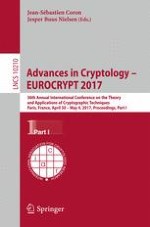2017 | OriginalPaper | Buchkapitel
One-Shot Verifiable Encryption from Lattices
verfasst von : Vadim Lyubashevsky, Gregory Neven
Erschienen in: Advances in Cryptology – EUROCRYPT 2017
Aktivieren Sie unsere intelligente Suche, um passende Fachinhalte oder Patente zu finden.
Wählen Sie Textabschnitte aus um mit Künstlicher Intelligenz passenden Patente zu finden. powered by
Markieren Sie Textabschnitte, um KI-gestützt weitere passende Inhalte zu finden. powered by
